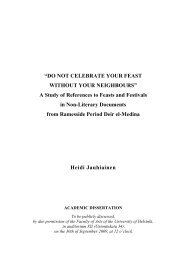BIA
bia51
bia51
You also want an ePaper? Increase the reach of your titles
YUMPU automatically turns print PDFs into web optimized ePapers that Google loves.
AVRIL 2015<br />
Today the Ministry of Trade and Industry is<br />
to hand over the 19 th century edifice of the<br />
Assay and Weights Administration in historic<br />
Cairo to the Ministry of Antiquities for<br />
restoration and to convert it into an authentic<br />
hotel.<br />
In addition to the rooms and restaurants,<br />
the Minister of Antiquities Mamdûh al-Damâtî<br />
said that the hotel will include a visitor centre<br />
that relates to the history of the Assay and<br />
Weights building from Mediaeval Egypt until the<br />
current era. The development of the hotel will<br />
be also shown through photos and documents.<br />
Muhammad ‘Abd al-‘Azîz, the assistant<br />
minister of antiquities for Islamic monuments,<br />
told Ahram Online that the building was<br />
completed in 1888 in the Bayt al-Qâdî area of<br />
historic Cairo in order to be the first premises<br />
for golden and silver coins. (Nevine El-Aref,<br />
“The Assay and Weights edifices in historic<br />
Cairo to become a hotel”, Ahram Online, April<br />
9, 2015).<br />
- -<br />
trenches worked on by the current mission,<br />
that ceramics of the Neolithic era were present.<br />
“This means that the settlement extents at<br />
least 200m south-west of what was formerly<br />
considered to be the boundary of the<br />
settlement,” ROWLAND told Ahram Online. She<br />
continued to say that the forthcoming<br />
investigations and post-excavation analysis<br />
would be able to confirm whether this newly<br />
discovered area was occupied during the latest<br />
periods of occupation of the settlement as<br />
anticipated, or whether it is from earlier times.<br />
ROWLAND and her team will reconsider the site<br />
within its wider geographic and environmental<br />
context.<br />
Minister of Antiquities Mamdûh al-Damâtî<br />
said that the team also unearthed a collection<br />
of ceramics and lithics of Neolithic dates and<br />
that more investigations will present much<br />
information about the various roads and means<br />
of living during this era.<br />
Merimde Banî Salâma is a major Neolithic<br />
settlement site on the western margin of the<br />
Delta, about 60km north-west of Cairo. The site<br />
is the largest and earliest known evidence of<br />
settlement in the Nile Valley or Delta region<br />
and has been given the name ‘Merimde’, which<br />
is the phase of Lower Egyptian Predynastic<br />
culture.<br />
Neolithic settlement<br />
During the recent archaeological season<br />
which ends in April, the mission of the Egypt<br />
Exploration Society uncovered new scientific<br />
evidence revealing that the borders of the<br />
major Neolithic settlement site of Merimde Banî<br />
Salâma on the western margin of the Delta,<br />
extends a further 200 metres to the south-west.<br />
Joanne ROWLAND, head of the mission,<br />
explained that they started the work to know<br />
about such extensions in the summer of 2014,<br />
after test trenches had been dug by the<br />
ministry of antiquities prior to the laying of a<br />
gas pipeline. It was then possible to examine<br />
the area just to the west of the modern<br />
asphalt road and it was also confirmed by the<br />
ministry investigations, as well as in test<br />
It was found in 1928 by German<br />
archaeologist Herman JUNKER who excavated<br />
the site throughout 1939. Through carbon<br />
dating, the site was occupied between 4880BC<br />
and 4250BC. Unfortunately, most of JUNKER’s<br />
notes were destroyed in World War II. EIWANGER<br />
has conducted more recent studies.<br />
The earliest level is characterised by a wide<br />
range of polished and unpolished untemper<br />
pottery decorated with a herringbone design.<br />
The Middle Merimde level shows complex<br />
structures of wood and basketwork, strawtempered<br />
pottery and many burials. Flint tools<br />
inserted into wooden, bone and ivory handles<br />
were also found.<br />
The later level of the Classic Merimde,<br />
considered the period of occupation, is when<br />
the settlement consisted of a large village of<br />
mud huts and workspaces in organised groups<br />
of buildings laid out in streets. The high level<br />
of organisation in the villages, indicated by<br />
<strong>BIA</strong> LI — Janvier/Juin 2015 87



